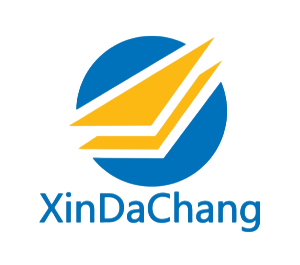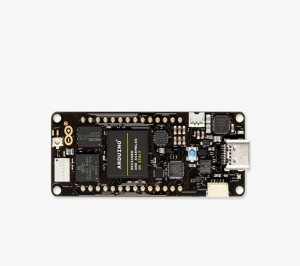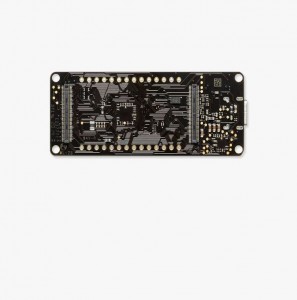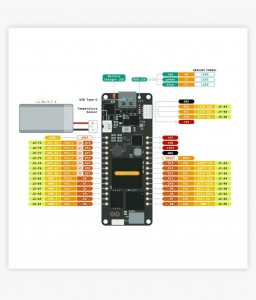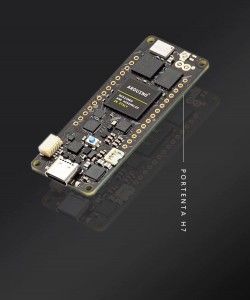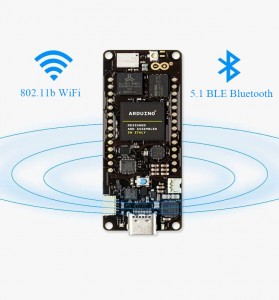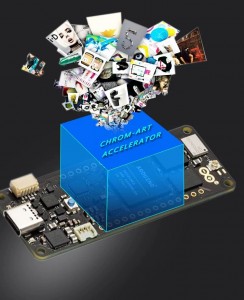Arduino PORTENTA H7 ABX00042 development board STM32H747 dual-core WIFI Bluetooth
Interboard connectivity
The Portenta H7 onboard wireless module allows simultaneous management of WiFi and Bluetooth connections, the WiFi interface can be connected simultaneously as an access point, workstation or dual mode, the WiFi interface can be operated as an access point, workstation or dual mode simultaneous AP/STA, and can handle transfer rates of up to 65MbPS. A range of different wired interfaces, such as UART, SPI, Ethernet or 12C, can also be exposed through some MKR style connectors or the new Arduino Industrial 80Pin connector pair
Product display
Portenta H7 runs both advanced code and real-time tasks. The design includes two processors that can run tasks in parallel. You can execute Arduino-compiled code with Micro Python and have the two cores communicate with each other. Portenta’s functionality is twofold, it can run like any other embedded microcontroller board, or it can run as the main processor of an embedded computer. Use the Portenta board to convert the H7 to an ENUC computer and expose all the H7 physical interfaces. Portenta makes it easy to run processes created using TensorFlow Lite, where you can have one of the cores dynamically compute computer vision algorithms while the other performs low-level operations, such as controlling motors or acting as a user interface. Use Portenta when performance is critical. In other cases we can think of: high-end industrial machinery, laboratory equipment, computer vision programmable logic controllers, industry-ready user interfaces, robotic controllers, mission critical equipment, dedicated fixed computers, high-speed start-up computing (milliseconds).
Two parallel cores:
The main processor of the Portenta H7 is the dual-core STM32H747, including the CortexM7 running at 480 MHz and the CortexM4 running at 240 MHz. The two cores communicate through a remote procedure call mechanism that allows seamless calls to functions on the other processor. Both processors share all on-chip hardware and can run: Arduino sketches on top of ArmMbed OS, native MbedTM applications, MicroPython/JavaScript via the interpreter, TensorFlowLite.
Graphics Accelerator:
The Portenta H7 can also connect to external displays to build your own dedicated embedded computer through the user interface. This is thanks to the GPU Chrom-ART Accelerator on the STM32H747 processor. In addition to the GPU, the chip includes a dedicated JPEG encoder and decoder.
New standard for pin assignment:
The Portenta series adds two 80-pin high-density connectors to the bottom of the development board. Simply upgrade the Portenta board to a development board that suits your needs to ensure scalability for a wide range of applications.
Onboard connection:
Onboard wireless modules allow simultaneous management of WiFi and Bluetooth connections. The WiFi interface can be used as an access point, workstation, or dual mode simultaneous AP/STA, and can handle transfer rates of up to 65 Mbps. Bluetooth interface supports Bluetooth Classic and BLE. A range of different wired interfaces, such as UARTSPI, Ethernet or 12C, can also be exposed through some MKR style connectors, or through the new Arduino Industrial 80-pin connector pair.
| Microcontroller | SRM32H747X1 Dual Correx-M7 +M432 bits Low Power ARM MCU (Data sheet) |
| Radio module | Murata 1DX Dual WiFi 802.11b /g/ n65Mbps And Bluetooth 5.1 BR /EDT /LE(data sheet) |
| Default security element | NXP SE0502(Data sheet) |
| Onboard power supply | (USB/NIN):5V |
| Support battery | 3.7V lithium battery |
| Circuit operating voltage | 3.3V |
| Current energy consumption | 2.95UA in standby mode (backup SRAM off, TRC/LSE on) |
| Display sub | MIP|DSI host and MIPID-PHY interface with low pin large display |
| GPU | Chrom-ART Graphics Hardware Accelerator |
| Timepiece | 22 timers and guard dogs |
| Serial port | 4 ports (2 ports with flow control) |
| Ethernet PHY | 10/100 Mbps (via expansion port only) |
| Operating temperature | -40°C to 85°C |
| MKR header | Use any existing industrial MKR shield |
| High density connector | Two 80-pin connectors expose all of the board’s peripherals to other devices |
| Camera interface | 8-bit, up to 80MHz |
| ADC | 3 * ADC, 16-bit resolution (up to 36 channels, up to 3.6MSPS) |
| Digital-to-analog converter | 2 12-bit Dacs (1 MHz) |
| USB-C | Host/device, DisplayPort output, high speed/full speed, power transmission |
Products categories
-

Phone
-

E-mail
-

Whatsapp
-

Skype
-

Skype
-

Skype
